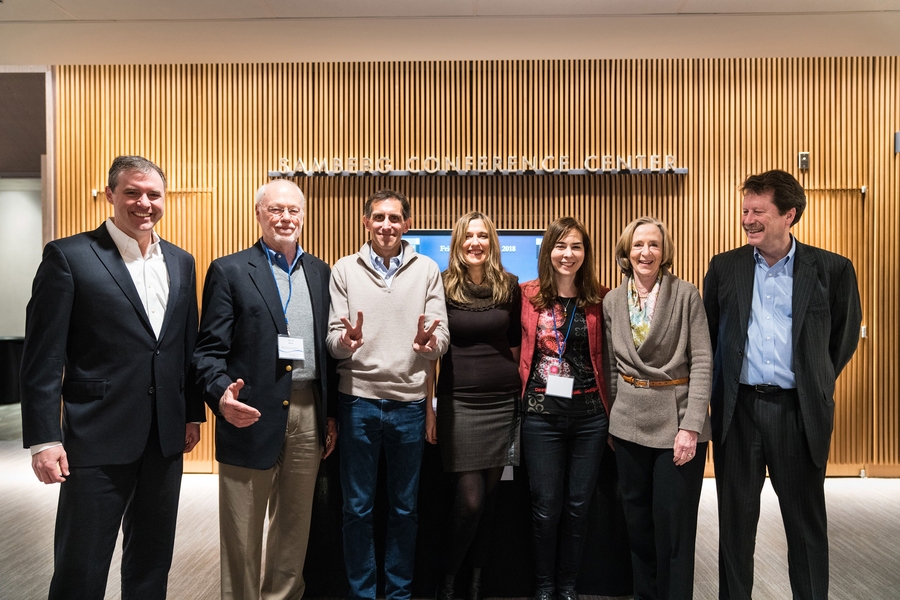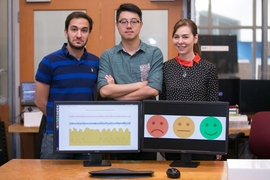MIT professors and MacArthur Fellows Regina Barzilay and Dina Katabi recently gathered leaders in technology, biotech, and regulatory agencies for a summit to inspire widespread adoption of artificial intelligence and digital technologies in health care.
MIT is surrounded by pharmaceutical companies, but until now there has been sparse connection between AI research at MIT and research on drug discovery. The fields have in essence spoken different languages and existed worlds apart.
Barzilay and Katabi are set to change that. Less than a year ago, they started a collaboration with pharmaceutical companies and quickly recognized a wealth of new research questions and an opportunity to transform the process of drug design and manufacturing.
“When Dina and I thought to organize this symposium, we wanted to bring these two communities together, and identify hard questions MIT and pharma can solve together,” said Barzilay, the Delta Electronics Professor in the Department of Electrical Engineering and Computer Science.
She and Katabi, the Andrew and Erna Viterbi Professor in the Department of Electrical Engineering and Computer Science, attracted 120 participants from 15 pharmaceutical companies, the U.S. Food and Drug Administration (FDA), area hospitals, and MIT colleagues in electrical engineering, computer science, biology, and business to the summit.
Bringing digital health to translational medicine
The morning kicked off with a welcome from Phillip Sharp, an MIT Institute Professor, professor of biology, and member of the Koch Institute for Integrative Cancer Research, who introduced keynote speaker Jay Bradner, the president of the Novartis Institute for BioMedical Research. Machine learning represents a “new wave to surf on” for the field of biomedicine, said Bradner.
“We so desperately need your help because this science has real challenges,” said Bradner, who leads 6,000 scientists located all over the world. Among them, he said, “150 are data scientists — and that’s not enough.” He ended his keynote with: “I know that together we can totally reimagine medicine.”
Academic researchers presented cutting-edge work and highlighted benefits for clinical trials, which test the safety and efficacy of a new drug. Katabi described a WiFi-like device that uses radio signals to monitor breathing and heart rate. It can also measure gait, detect falls, and monitor sleep and apnea. Katabi emphasized that “the device extracts this information by analyzing the radio waves in the environment. So, there is no overhead to the patient, and no need to wear sensors.” The device is currently deployed with Parkinson’s and Alzheimer’s patients and is used to understand the impact of the disease on mobility, sleep, and dependence on the caregiver.
“Can we leverage complex biological knowledge and vast amount of clinical and genomic data to change the cancer drug discovery process?” asked Dimitris Bertsimas, the Boeing Professor of Operations Research at the MIT Sloan School of Management. He is working on a data-driven approach that involves personalized genomic cancer therapy.
Caroline Uhler, the Henry L. and Grace Doherty Assistant Professor in the Department of Electrical Engineering and Computer Science, described the spatial organization of the genome and early cancer detection using neural networks.
“Biomedicine is at an inflection point,” said Andrew Lo, the Charles E. And Susan T. Harris Professor at the MIT Sloan School of Management. As people heed the convergence of the science, engineering, and therapeutics — let’s also consider the economics, he said.
He described using computer algorithms for statistical analysis of the financial returns to biotech and pharmaceutical investments if they invest in a drug’s development. Machine learning models can finely estimate probabilities of success of clinical trials, he said.
“Investors want to know the chance of success,” he said. “You hear talk of Big Pharma getting out of Alzheimer’s because the failure rate in clinical trials have led them to see it as a “black hole.” But if you have more refined analytics that might provide some hope to investors and might attract them to invest.”
AI for better results
Other presentations delved into a wide range of improvements enabled by digital technologies. Barzilay described using machine learning to detect cancer with a complex neural model that can explain the why behind its decisions. “Our model offers interpretability with concise evidence. It takes neural networks and breaks data apart in smart ways to give you an explanation,” she said.
Tommi Jaakkola, the Thomas Siebel Professor in the Department of Electrical Engineering and Computer Science, highlighted the use of machine learning in chemistry. He said it’s time to draw computationally on the millions of known reactions in databases only partially explored — such as articles in chemical, medical, or biological journals and in private repositories. “By digesting the information at scale we can really improve the state of the art,” he said. “The design, the discovery, the optimization. This area is on the verge of exploding.”
This work is currently developed as part of the Machine Learning for Pharmaceutical Discovery and Synthesis Consortium that includes leading pharmaceutical companies and MIT team of computer scientists and chemical engineers.
David Sontag, an assistant professor in the Department of Electrical Engineering and Computer Science, said he wants to see data from claims, clinical trials, disease registries and more used by machine learning for population-level understanding of disease progression.
The adoption of electronic health records in U.S. hospitals has increased nine-fold since 2008 from 9.4 percent to 83.8, he said with approval. But the challenges of machine learning using clinical data are significant, including the amount of missing and heterogeneous data.
Ray Dorsey, the David M. Levy Professor of Neurology at the University of Rochester Medical Center, presented on the “tremendous insights” that Katabi’s technology is delivering for people with Parkinson’s disease.
“We can visualize both their location and frequency and movements and all that can be tracked accurately across long time spans. Until now, our perspective of a patient’s illness experience was episodic and limited,” he said. “Maybe next year, I can come back and say we have highly effective treatments for this disease.”
Shaping the future
During an afternoon panel, MIT President Emerita Susan Hockfield, a professor of neuroscience in the MIT Department of Brain and Cognitive Sciences, asked: “If we’re lucky, looking forward, how will the FDA onboard digital and machine learning devices?”
“Things have to change, but the fundamental that shouldn’t change is that you have to validate that your technology has human benefit and the benefits outweigh the risk for the intended uses,” said Robert Califf, the vice chancellor for health data science at Duke University and former FDA commissioner.
After the summit, Sharp, a pioneering molecular biologist who earned a Nobel Prize for his co-discovery of RNA splicing, said it had highlighted the promise of AI and digital technologies for improving the lives of patients.
“I expect that working groups will emerge from the meeting that will both formulate collaborative research programs and attract strong financial support,” Sharp said. “It was widely appreciated that the recent remarkable advances in AI and digital technologies will transform biomedical sciences and health care. This vision gave rise to palpable excitement in the audience that will move promise to accomplishment."














